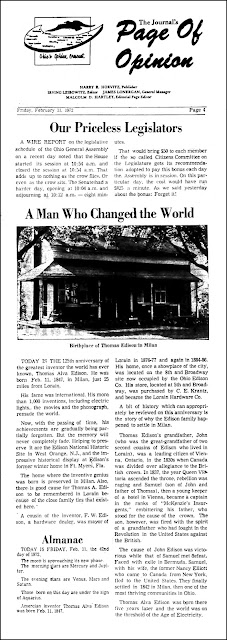 |
| Portrait of Thomas A. Edison by Ellis M. Silvette in 1926 (Postcard Courtesy of eBay) |
Today is the 175th anniversary of the birth of Thomas Alva Edison.
Fifty years ago on the 125th anniversary, the Journal ran a special editorial tribute to the great inventor. It’s particularly well written and includes an interesting Lorain connection to the Edison family that many people might not be aware of.
A Man Who Changed the World
TODAY IS THE 125th anniversary of the greatest inventor the world has ever known, Thomas Alva Edison. He was born Feb. 11, 1847, in Milan, just 25 miles from Lorain.
His fame was international. His more than 1,000 inventions, including electric lights, the movies and the phonograph, remade the world.
Now, with the passing of time, his achievements are gradually being partially forgotten. But the memory will never completely fade. Helping to preserve it are the Edison National Historic Site in West Orange, N.J., and the impressive historical display at Edison’s former winter home in Ft. Myers, Fla.
The home where the inventive genius was born is preserved in Milan. Also, there is good cause for Thomas A. Edison to be remembered in Lorain because of the close family ties that existed here.
A cousin of the inventor, F. W. Edison, a hardware dealer, was mayor of Lorain in 1876-77 and again in 1884-86. His home, once a showplace of the city, was located on the 8th and Broadway site now occupied by the Ohio Edison Co. His store, located at 5th and Broadway, was purchased by C. E. Krantz, and became the Lorain Hardware Co.
A bit of history which can appropriately be reviewed on this anniversary is the story of why the Edison family happened to settle in Milan.
Thomas Edison’s grandfather, John (who was the great-grandfather of two second cousins of Edison who lived in Lorain), was a leading citizen of Vienna, Ontario, in the 1830s when Canada was divided over allegiance to the British crown. In 1837, the year Queen Victoria ascended the throne, rebellion was raging and Samuel (son of John and father of Thomas), then a young keeper of a hotel in Vienna, became a captain in the ranks of “McKenzie’s Insurgents,” embittering his father, who stood for the cause of the crown. The son, however, was fired with the spirit of a grandfather who had fought in the Revolution in the United States against the British.
The cause of John Edison was victorious while that of Samuel met defeat. Faced with exile in Bermuda, Samuel, with his wife, the former Nancy Elliott who came to Canada from New York, fled to the United States. They finally settled in 1842 in Milan, then one of the most thriving communities in Ohio.
Thomas Edison was born there five years later and the world was on the threshold of the Age of Electricity.
****
I’ve written about Thomas Edison before, including this two-part series (here and here) about the 1947 Edison Centennial, as well as this post featuring a 1959 Edison Birthday article.
And don’t miss the profile of a man whose claim to fame was explored in this post entitled, “He Cut Edison’s Hair,” or this post about my family’s visit to Edison’s birthplace in 1962.

I recently read a book titled "The Vagabonds". The book is the story of an approximately 10 year period from 1914 through 1924. Each summer during this period Henry Ford, Thomas Edison, Harvey Firestone, joined for a few years by naturalist John Burroughs, would spend a couple weeks traveling around the county on a vacation. They would car camp rather then stay at hotels. Henry Ford would of course provide the specially furnished car used during the excursions, and the trips, and various stops were highly covered by the press and avidly followed by the public. Thomas Edison was probably the best known American at the time, and I'm sure Ford and Firestone didn't mind the free publicity. The book is light, but interesting reading.
ReplyDelete...Dan,
ReplyDeleteI remember one of our class field trips at Masson went to the Thomas Edison home and museum in Milan - a wonderful and fascinating place!
Dan,
ReplyDeleteSome interesting things to comment here.
You can visit the Henry Ford Museum in Dearborn, Michigan, and tour Edison's laboratory. Ol' Henry had the whole thing moved there and consulted with the people who worked there to get everything perfect, down to the chemical bottle locations on the shelves that you can see today.
Also, Kingsford charcoal was a result of Henry Ford. He sought a lumber source and annoyed with the waste from scrap wood from building Model T's and packaging, enlisted others to make a marketable solution to the offcuts. To facilitate sales, Ford had dealers sell "picnic kits" through Ford dealers, thus popularizing and having an outlet to sell the ubiquitous charcoal briquette.